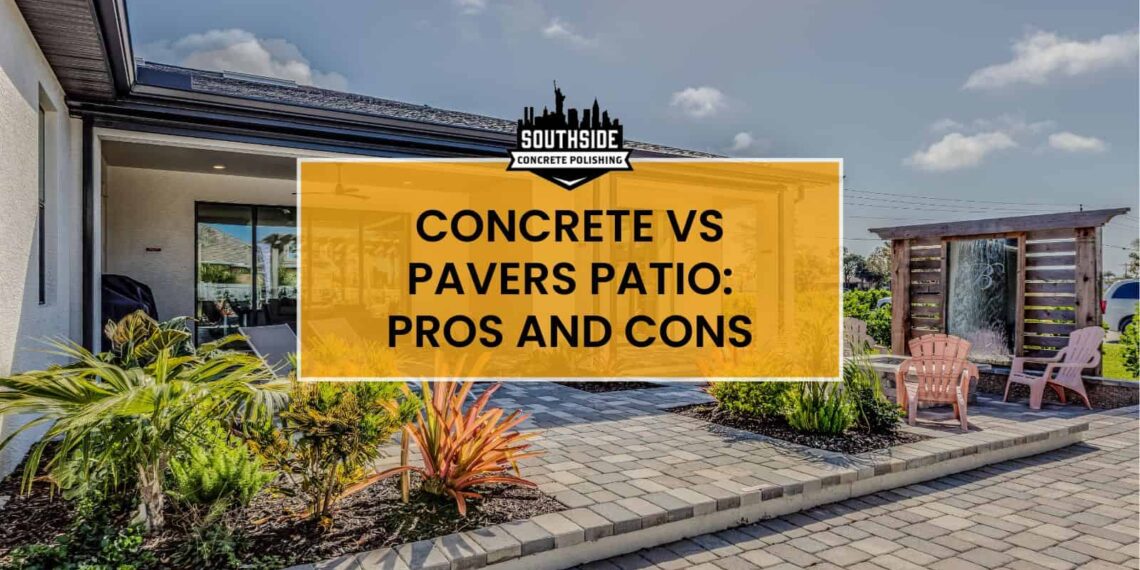Embark on a journey through the realm of outdoor living spaces with a detailed exploration of Concrete vs. Paver Patio: Pros, Cons, and Cost Comparison. Discover the key differences and factors to consider when choosing between these two popular options.
Delve into the intricacies of design, durability, maintenance, and cost to make an informed decision for your patio project.
Concrete Patio
Concrete patios are known for their durability, making them a popular choice for outdoor spaces. The solid nature of concrete ensures that it can withstand heavy foot traffic, furniture, and outdoor elements without easily wearing down.
Durability
Concrete patios are highly durable and can last for decades with proper maintenance. They are resistant to weather conditions, such as rain, snow, and heat, making them a reliable option for long-term use.
Maintenance Requirements
In comparison to paver patios, concrete patios have lower maintenance requirements. Regular cleaning and occasional sealing are typically all that is needed to keep a concrete patio looking its best. This makes them a convenient choice for homeowners looking for a low-maintenance outdoor space.
Design Options
Concrete patios offer a wide range of design options, including stamped patterns, colored finishes, and textured surfaces. Homeowners can customize their concrete patio to match their aesthetic preferences and enhance the overall look of their outdoor area.
Cost
The average cost of installing a concrete patio ranges from $6 to $15 per square foot, depending on factors such as the complexity of the design, site preparation, and labor costs. While initial installation costs may be higher than some other patio options, the long-term durability and low maintenance requirements of concrete patios can make them a cost-effective choice in the long run.
Paver Patio
When it comes to outdoor living spaces, paver patios offer a versatile and stylish option for homeowners looking to enhance their backyard. The use of pavers allows for a wide range of design possibilities, making it easy to create a patio that complements the overall aesthetic of your home.
Versatility of Paver Patios
Paver patios are known for their versatility in design, as they come in a variety of shapes, sizes, colors, and textures. This allows homeowners to customize their patio to suit their personal style and preferences. Whether you prefer a traditional look with classic brick pavers or a more modern feel with sleek, contemporary pavers, the options are endless.
Installation Process of Paver Patios
The installation process of a paver patio involves several steps, including preparing the base, laying out the pavers in the desired pattern, cutting any pavers as needed to fit the space, and finally filling the gaps between the pavers with sand or gravel.
While the process may seem labor-intensive, hiring a professional can ensure a smooth and efficient installation.
Longevity of Paver Patios
Paver patios are known for their durability and longevity, often outlasting concrete patios. The individual pavers can be easily replaced if damaged, without the need to redo the entire patio. With proper maintenance and care, a paver patio can last for decades, making it a worthwhile investment for homeowners.
Cost Factors of Installing a Paver Patio
The cost of installing a paver patio can vary depending on factors such as the size of the patio, the type of pavers chosen, the complexity of the design, and the labor costs in your area. While paver patios may initially be more expensive than concrete patios, their longevity and aesthetic appeal make them a popular choice for many homeowners looking to enhance their outdoor space.
Pros and Cons
Concrete patios and paver patios each have their own set of advantages and disadvantages, including environmental impact, repair processes, aesthetic appeal, and overall functionality.
Environmental Impact
Concrete patios tend to have a higher environmental impact compared to paver patios. The production of concrete involves mining and processing raw materials, such as limestone, which can contribute to carbon emissions. On the other hand, paver patios are often made from recycled materials and can be recycled at the end of their lifespan, reducing waste and environmental impact.
Repair Process
When it comes to repairs, concrete patios can be more challenging and costly. Cracks in concrete can be difficult to repair seamlessly, often requiring the entire slab to be replaced. In contrast, paver patios are easier to repair as individual pavers can be removed and replaced without affecting the rest of the patio.
Aesthetic Appeal
Concrete patios offer a more modern and clean look, with the ability to be stamped or stained for a customized appearance. However, paver patios provide a more natural and rustic aesthetic, with a wide range of colors, shapes, and patterns to choose from.
The versatility of pavers allows for creative designs and unique layouts.
Advantages and Disadvantages
Concrete patios are known for their durability and longevity, requiring minimal maintenance over time. They are also cost-effective and can be poured in one large slab for a seamless look
However, they may require more maintenance over time, as individual pavers can shift or settle. Additionally, paver patios tend to be more expensive upfront due to the cost of materials and installation labor.
Cost Comparison
When deciding between a concrete or paver patio, cost is a significant factor to consider. Let's compare the initial cost, maintenance cost, and lifespan of these two options to help you make an informed decision for your outdoor space.
Initial Cost, Maintenance Cost, and Lifespan
- Concrete Patio:
- Initial Cost: Concrete patios typically have a lower initial cost compared to paver patios. The cost can vary depending on the quality of the concrete and the complexity of the design.
- Maintenance Cost: Concrete patios may require occasional sealing to prevent cracks and stains. Repairs can also be more costly compared to paver patios.
- Lifespan: With proper maintenance, a concrete patio can last around 25-30 years.
- Paver Patio:
- Initial Cost: Paver patios tend to have a higher initial cost due to the materials and installation process. However, the cost can vary based on the type of pavers chosen.
- Maintenance Cost: Paver patios may require occasional replacement of individual pavers and re-leveling. However, repairs are usually less expensive compared to concrete patios.
- Lifespan: A well-maintained paver patio can last 30-50 years or more.
Impact of Location and Size on Overall Cost
The location and size of your patio can significantly impact the overall cost of installation. Factors like accessibility, ground preparation, and labor costs can vary depending on the site conditions and size of the patio. Larger patios or those in hard-to-reach areas may incur higher installation costs.
Additional Costs
In addition to the initial installation cost, there are other expenses to consider for both concrete and paver patios. These may include:
- Excavation and site preparation
- Edging materials
- Sealing or finishing treatments
- Gravel base and sand for paver installation
- Professional installation labor
Tips for Budgeting
- Get multiple quotes from reputable contractors to compare costs.
- Consider the long-term maintenance expenses when budgeting for your patio.
- Factor in any additional features or customizations you want for your patio design.
- Plan for unexpected expenses by setting aside a contingency fund in your budget.
Closing Notes
As we draw the curtains on our discussion of Concrete vs. Paver Patio: Pros, Cons, and Cost Comparison, remember that the perfect patio is not just a surface but a reflection of your lifestyle and preferences. Choose wisely and create a space that enhances your outdoor experience.
FAQs
Are paver patios more expensive than concrete patios?
While the initial cost of paver patios is typically higher than concrete patios, the long-term maintenance costs may vary.
Which is more environmentally friendly: concrete or paver patios?
Paver patios are considered more eco-friendly as they allow better water drainage and reduce heat absorption compared to concrete.
How long does a concrete patio last compared to a paver patio?
Concrete patios can last for decades with proper maintenance, whereas paver patios may need occasional repairs but offer flexibility in design.






